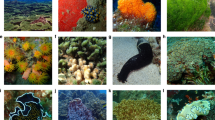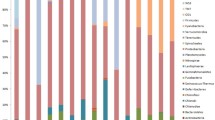Abstract
Symbiotic cyanobacteria are associated with marine sponges in three ways: the majority are free-living in the mesohyl; large aggregates occur in “cyanocytes” (specialized, vacuolated archeocytes); and few are present in digestive vacuoles. The cyanobacteria in Jaspis stellifera and Neofibularia irata are morphologically similar to those described in Mediterranean sponges, whereas those in Pericharax heteroraphis are different. The freeliving bacterial populations are morphologically similar, although the number of bacteria varies between the species. The fourth sponge Ircinia wistarii contains a mixed bacterial population unlike those in the other sponges. Sponge digestion of microbial associates is rare and not considered to contribute significant nutrients.
Similar content being viewed by others
Literature Cited
Feldmann, J.: Sur quelques cyanophycées vivant dans le tissu des éponges de Banyuls. Archs Zool. exp. gén. 75, 381–404 (1933)
Hildemann, W.H., R.L. Raison, G. Cheung, C.J. Hull, L. Akaka and J. Okamoto: Immunological specificity and memory in a scleractinian coral. Nature, Lond. 270, 219–223 (1977)
Lévi, C. et A. Porte: Etude au microscopie électronique de l'éponge Oscarella lobularis Schmidd et se larve amphiblastula. Cah. Biol. mar. 3, 307–315 (1962)
Reiswig, H.M.: Particle feeding in natural populations of three marine demosponges. Biol. Bull. mar. biol. Lab., Woods Hole 141, 568–591 (1971)
Sarà, M.: Ultrastructural aspects of the symbiosis between two species of the genus Aphanocapsa (Cyanophyceae) and Ircinia variabilis (Demospongiae). Mar. Biol. 11, 214–221 (1971)
Smith, D.C., L. Muscatine and D.H. Lewis: Carbohydrate movement from autotrophs to heterotrophs in parasitic and mutualistic symbiosis. Biol. Rev. 44, 17–90 (1969)
Vacelet, J.: Description de cellules a bactéries intranucléaires chez des éponges Verongia. J. Microscopie 9, 333–346 (1970)
—: Etude en microscopie électronique de l'association entre une cyanophycée chroococcale et une éponge du genre Verongia. J. Miscroscopie 12, 363–380 (1971)
— Etude en microscopie électronique de l'association entre bactéries et spongiaires du genre Verongia (Dictyoceratida). J. Microscopie Biol. cell. 23, 271–288 (1975)
Wiebe, W.J. and G.B. Chapman: Fine structure of selected marine pseudomonads and achromobacters. J. Bact. 95, 1862–1873 (1968)
Wilkinson, C.R.: Microbial associations in sponges. I. Ecology, physiology and microbial populations of coral reef sponges. Mar. Biol. 49, 161–167 (1978a)
— Microbial associations in sponges. II. Numerical analysis of sponge and water bacterial populations. Mar. Biol. 49, 169–176 (1978b)
Wolk, C.P.: Physiology and cytological chemistry of blue-green algae. Bact. Rev. 37, 32–101 (1973)
Author information
Authors and Affiliations
Additional information
Communicated by G.F. Humphrey, Sydney
Rights and permissions
About this article
Cite this article
Wilkinson, C.R. Microbial associations in sponges. III. Ultrastructure of the in situ associations in coral reef sponges. Mar. Biol. 49, 177–185 (1978). https://doi.org/10.1007/BF00387117
Accepted:
Issue Date:
DOI: https://doi.org/10.1007/BF00387117




